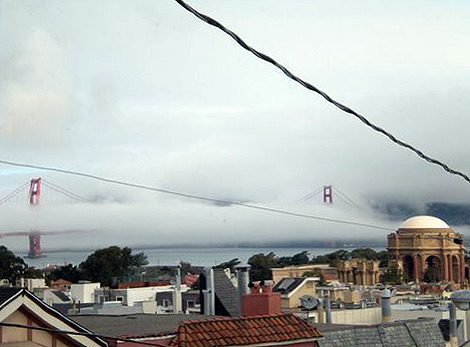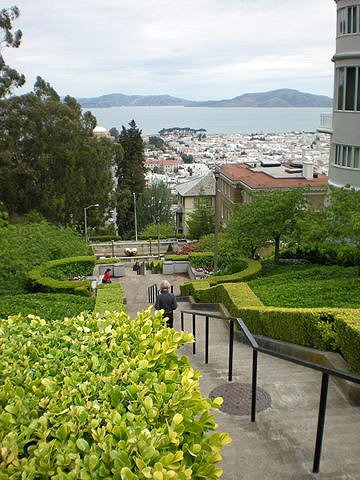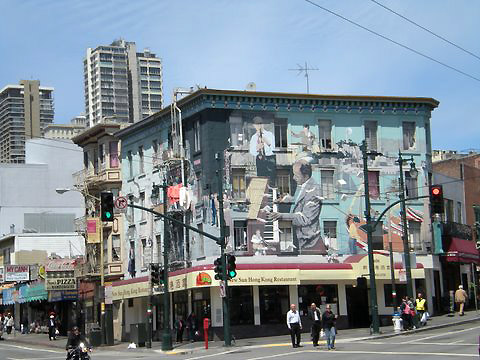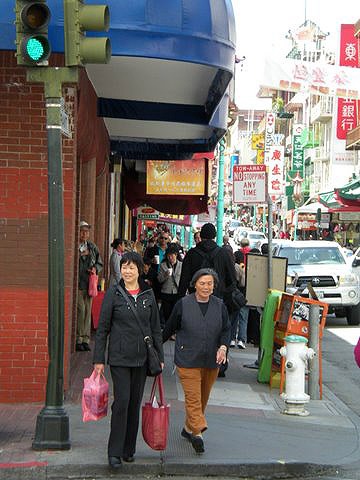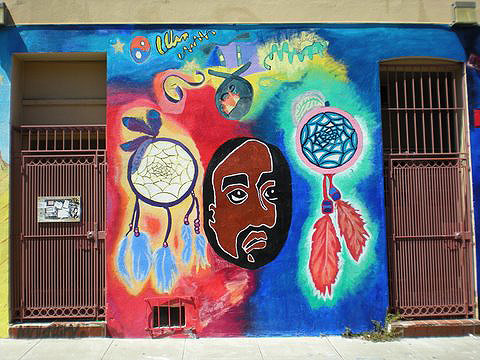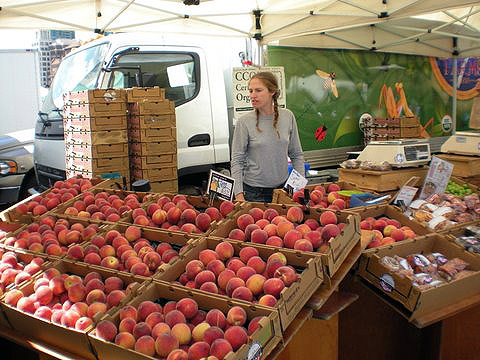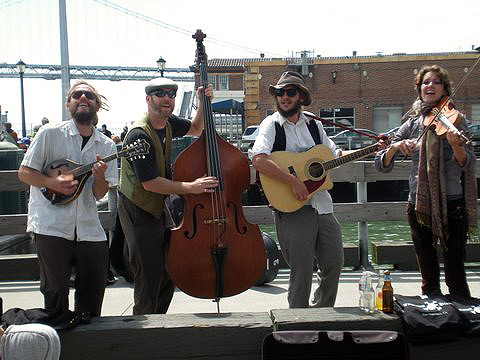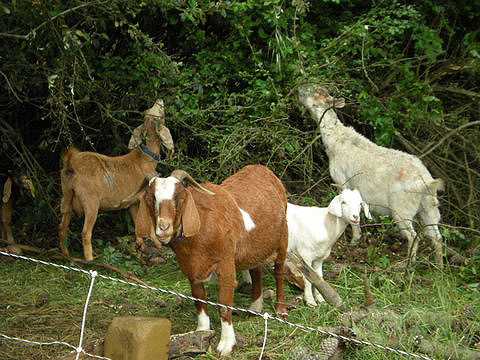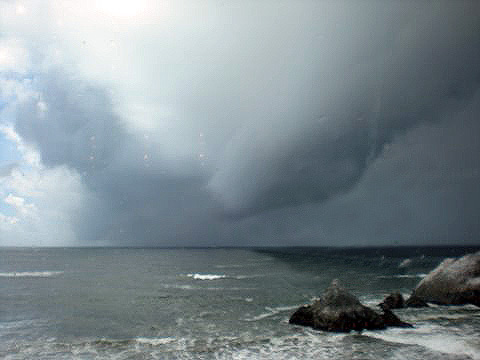 |
 |
|
 |

|
San
Francisco, the Golden Gate
by Corinna Lothar
Sometimes, the bridge gleamed golden beneath a cloudless bright blue sky; sometimes I could see the top half of the towers when the morning fog hid the rest of the bridge; and sometimes I couldn’t see the bridge at all when it was enveloped in a silent blanket of white fog. The mournful sound of foghorns mixed with less romantic city sounds.
When I was growing up in San Francisco many years ago, the foghorns lulled me to sleep. Radar and other technological safety measures invented in the ensuing years made the foghorns obsolete and the city silenced them. But public outcry at this very San Francisco sound brought them back. They are no longer necessary for the safety of ships, only for the city’s sense of self. I was lucky to be apartment sitting for a few weeks in the apartment of a friend who was off in London for a holiday. Her picture window in the living room framed the bay, the bridge, Angel Island and Alcatraz, no longer a threatening reminder that crime doesn’t pay. Like parts of the city itself, Alcatraz has been revamped into something more contemporary, and the Rock is now a tourist site. The apartment was situated on one of the city’s steep hills on the north side of Pacific Heights, overlooking Cow Hollow, the Marina and the Palace of Fine Arts. I spent three happy weeks exploring the San Francisco I remembered and discovering the changes that had occurred in the intervening decades.
San Francisco cannot grow, except in height, as it is the tip of a peninsula, surrounded on three sides by water, and on the fourth side by the county line below which is the separately incorporated city of South San Francisco, which locals are quick to inform you is not part of The City. High rise buildings replace the four and five storied buildings that once housed the downtown offices and shops where gentlemen in ties and hats and ladies in gloves and hats went about their respective business. In those years of my childhood, women would not think of venturing “downtown” to go shopping in the White House, Magnin’s, the City of Paris or even the less fancy Emporium on Market Street, without being properly dressed. Ladies were not permitted unescorted in the bars of the Fairmont and Mark Hopkins Hotels atop Nob Hill. My mother and I were once asked to leave the bar at the Top of the Mark for that reason. The slowly rotating bar still exists, but the rules have changed. The Fairmont’s Tonga Room, once a “must” locale for dating couples as well as tourist groups, is barely hanging on. There’s talk of closing down the funky bar with its timed rain showers and exotic drinks. What hasn’t changed are many of the residential neighborhoods: Presidio Heights with its elegant mansions; the ubiquitous Victorian and Edwardian houses – San Francisco’s “painted ladies” - some beautifully renovated, but others badly needing repair; the Sunset with its rows of pastel colored two story houses lining the avenues near the beach. In North Beach, the sun shines most of the time and the Italian restaurants and cafes are more numerous than ever: Lupo’s – which opened in 1935 with the first wood-burning brick pizza oven on the West Coast - is now called Tomasso’s but continues to be famous for its pizza; Molinari Delicatessen still has its house-made salamis hanging above the counter. City Lights Book Store, once home to Allen Ginsberg, Gregory Corso, Jack Kerouac and the rest of the Beatniks, as well as Vesuvio Café, where they hung out are only slightly changed. Tiny Café Trieste continues to froth the best cappuccinos and espressos in the city.
Chinatown, which adjoins North Beach (and where there’s an alley named for Jack Kerouac), is perhaps more Chinese than it ever was. The shops and restaurants along Grant Avenue are a tourist destination but the streets are alive with the chatter of Chinese women at their daily marketing, old men playing card games in doorways, and children skipping happily on their way home from school. Out in the Richmond District, Clement Street once was home to shops and restaurants run by Europeans, refugees from World War II. Today, Clement Street is almost exclusively oriental with Chinese grocery stores, dim sum take-out shops, Thai, Vietnamese and Chinese restaurants. The fabulous Green Apple Bookstore offers a browser great bargains. South of Market (“SoMa”) has changed a lot. The Mission District is a lively section of town where the sounds and aromas of Mexican tiendas perfume the air, and walls are splashed with murals. The Castro is the gay center of the city, where many of the newer, trendy restaurants are located.
In the downtown part of the city, South of Market is home to high rise hotels, the Moscone Center and the Museum of Modern Art, as well as a new station for trains running down the Peninsula. Union Square remains the heart of San Francisco’s shopping district, but the names on the department stores have changed; the Square has been cleaned up and now is a gathering place for the lunch crowd. The St. Francis Hotel continues to reign over the Square and a handful of the old-time elegant shops, like Gump’s, are still there. Commuters and visitors can take a ferry from the Ferry Building to Oakland or to Marin County, but the building serves as a high-end food court. On Saturday mornings, the sidewalk in front of the Ferry Building and the area behind it are replete with vendors selling wonderful California produce, flowers, breads, cheeses and prepared foods. Several restaurants have carry-out windows for the hundreds of locals and tourists who have come to shop, look and enjoy breakfast and brunch specialties.
Young musicians and performers entertain the crowds, entrancing the children. When the sun is out, the breeze is blowing and the sky is a brilliant blue, it’s a scene to remember.
San Franciscans have always prided themselves on the city’s cultural scene: first class museums, an excellent symphony orchestra, the country’s second largest opera company, the American Conservatory Theatre resident repertory company, string quartets, community theatres, art galleries and special events. In Golden Gate Park, the Japanese Tea House (renamed Chinese Tea House during World War II) is a lovely oasis within the city’s green space. The Steinhart Aquarium has become a complex including a planetarium, natural history museum, and four-story rain forest, as well as an aquarium with 38,000 animals from around the world. Across from the aquarium is the newly designed De Young Museum of fine art. The museum, founded in 1895 and named for early San Francisco newspaperman M.H. de Young, was a fine arts museum showing primarily European art. It was badly damaged in the 1989 Loma Prieta earthquake and has now been completely rebuilt into a contemporary structure. The museum’s European collection was sent to the Legion of Honor museum, and the de Young now showcases American art from the 17th to the 21st centuries, international contemporary art, textiles, and art from the Americas, the Pacific and Africa. Beginning on September 25 until January 18, 2011, the de Young will show Post-Impressionist Masterpieces from the Musee d’Orsay in Paris. On a hill, almost at Land’s End, the western end of the city, sits the Palace of the Legion of Honor, a three-quarter scale copy of the Palais de la Legion d’Honneur in Paris. It is perched on an elevated site in Lincoln Park where the public Lincoln Park Golf Course spreads out on the site of a former potter’s field, the Golden Gate Cemetery, which the city bought in 1867. The cemetery was closed in 1908 and the remains moved down the Peninsula. The museum has been renovated into a bright, airy space. Even if a visitor doesn’t want to explore the museum itself, its location offers a magnificent view of the Golden Gate Bridge and the Marin County headlands. The Asian Museum occupies what was formerly the San Francisco Public Library near the Civic Center. The Jewish Museum and a delightful small Craft Museum are near the Modern Museum downtown. San Francisco’s rich musical history dates back almost 100 years to the founding of the San Francisco Symphony. The orchestra has been conducted by many of the world’s most famous conductors. Its current music director is Michael Tilson Thomas who has been leading the orchestra since 1995. Performances are given thrice weekly. Opera companies have been coming to San Francisco since the gold rush. The San Francisco Opera was founded by Gaetano Merola in 1923, and is the second largest opera company in North America next to the Metropolitan in New York. Since 1954, the Merola Opera Program has offered scholarships and training to outstanding young singers. San Franciscans love the outdoors. Not only is the city dotted with a wealth of small parks and spacious Golden Gate Park with its wealth of tourist attractions, ponds and paths, but the Presidio, a military reservation for more than a century, has become a large playground for all ages. The Presidio’s wooded hills, eucalyptus trees and hiking paths lie at the northernmost tip of the San Francisco peninsula. You can drive or hike through it, from Pacific Heights north to the Marina or west to the Pacific Ocean. A small herd of goats moves about eating the grass and the poison oak.
The Presidio has a long military history beginning with el presidio real de San Francisco, the first Spanish fort established in 1776. In 1846, the garrison came under the control of the U.S. Army and the Presidio became a beautiful military post. In 1994, the U.S. Army transferred the land to the National Park Service. The houses once reserved for Army officers are now rented by private citizens. What once was the Letterman Army Hospital has been remodeled into the Letterman Digital Arts Center, housing George Lucas’ Lucasfilm. There’s a children’s swimming school in the Presidio, several commercial enterprises and Crissy Field has been transformed from an airfield into a recreation area resembling the original shoreline of dunes, lagoons and tidal marshes. Running from the Marina to Fort Point, the only Civil War-era casemated fort in the West, Crissy Field is now a reserve of walking and bicycling trails. Fort Point sits directly below the Golden Gate Bridge. The Presidio has several restaurants, including one in what was once a barracks. There’s a “warming hut” on Crissy Field for hikers in need of refreshment. Food and drink have always been a San Francisco priority. Not much is left of the wild Barbary Coast days. When I was growing up, fine dining was limited to downtown San Francisco; Chinatown offered group dining at about $1 per person. North Beach restaurants offered “spaghetti with red sauce” and the young singers with operatic aspirations entertained guests at the Bocce Ball. Amelio’s, the Blue Fox and Ernie’s, alas, are gone with the wind. But Tadich Grill in the financial district on California Street still serves delicious sand dabs. And Swan Oyster Company on Polk Street continues to supply the hostesses of Pacific Heights with the freshest smoked salmon, bay shrimp and cracked crab. The counter still seats only about a dozen people where you can enjoy the best shrimp Louie the city has to offer, along with a glass of California white wine and extra sour French bread. Today, you find restaurants of all kinds in all neighborhoods. The best Thai and Chinese food is found on Clement Street; much of the old tenderloin district is now Little Saigon, with tiny restaurants like the Turtle Tower, which serves a dozen different soups and unusually tasty spring rolls. In what once was a semi wasteland near the Ferry Building, south of Market Street, there are now high rise office buildings, the new federal court building and several very good restaurants, including Prospect, the newly trendy contemporary American restaurant. On Fillmore Street, there’s the Woodhouse Fish Co. where you can get a lobster roll as good as any in Massachusetts, or a huge stuffed artichoke. Fillmore Street has lots of small, excellent restaurants and the street is lined with interesting shops. The owner of Suriya Thai Restaurant moved his restaurant and his collection of beautiful wooden coconut graters, carved in animal forms, to an unlikely industrial area south of Market. Well worth a visit. The Hayes Street Grill has long been a good place for lunch before (or after) a court appearance at City Hall, or dinner before a performance in the Opera House. On Union Street in Cow Hollow, there are ample choices, such as Rose’s Café, Italian specials are prepared with a light touch. Ristobar serves very contemporary American fare on Chestnut Street. In the Castro district, Frances is popular for unusual small plates. The Cliff House has been a favorite tourist destination in San Francisco since 1863. Today’s Cliff House is the third one to occupy the site high on a rock overlooking the Pacific Ocean where the beach, long ago, resounded with Playland’s merry-go-round tunes mixed with the cries of seagulls. The Cliff House has been remodeled and what was a simple bar and restaurant with a splendid view is now a white tablecloth restaurant with a splendid view. The ruins of the Victorian-era Sutro Baths next to the Cliff House are worth a look. Gales blow around the building, even when the sun is shining, and the Pacific is anything but pacific. Look from a table by the window at Seal Rock and the storm clouds blowing in while the gulls wheel above and the ships move slowly out the Golden Gate, bound for Shangri-La and points beyond. You’re at the end of the continent, safe from the coming storm in one of the most beautiful and exciting cities in the world.
|
I found a Mich Goss J. Grassmayr Innsbruck bell with Jesus,
a crucifix and a flower on it. Do you have any information about it you can
share with me? Many thanks. I don't have any information on that specific bell. If she wants information, "Liz" in San Bernardino should contact the factory. Here is the information: Address Grassmayr Foundry and Bell Museum, Leopoldstrasse 53, Inssbruck, A-6010 Austria. Telephone: 43 512-59416-0. Fax: 43 512-59416-22. E-mail: johannes@grassmayr.at or info@grassmayr.at. Corinna
Been there -- thought I'd done it -- you proved me wrong. Great travel coverage -- even for those who have lived there. --- Bill, Redmond, Oregon
Corinna, my dear, What a wonderful series of words you have collected together to paint a mesmerizing story about one of my favorite places. Even though I've traversed these same locales as you many times, your delightful descriptions made me want to book a flight this very second and see again some of the places that time did not allow me to linger in before. Your photos are also riveting, and I loved the pantyhose one - what a clever, sexy way to promote that article of the female form. Your colorful words make the entire region literally come alive before my eyes - a rare gift for any writer! Bravo and again Congrats on your top notch feature. Best regards. Best regards,
Hello Corinna, This is very roundabout ... I was recently teaching (Legal Reasoning) in Kabul and encountered Ann Geracimos, who said she knows you from the Times. She recently provided me with an electronic version of your 2007 piece about returning to Frankfurt (which I enjoyed very much). Jonelle and I are well (and enjoying our 3 grandchildren, who live within blocks of our house). I hope you are well. I will now look for your travel writing regularly. Best regards,
What an amazing background Ms. Lothar has! I enjoyed her article
very much. I found it to be quite intriguing, especially the interpreter school
bit.
I loved your article on Metz. I was an exchange student living there from 1981-1982 and have always felt like Lorraine was the most overlooked part of Europe. You really captured the feel of the city with your photo and articles.
|
![]()
Stay tuned.
This site is designed and maintained by WYNK Marketing. Send all technical issues to: support@wynkmarketing.com












